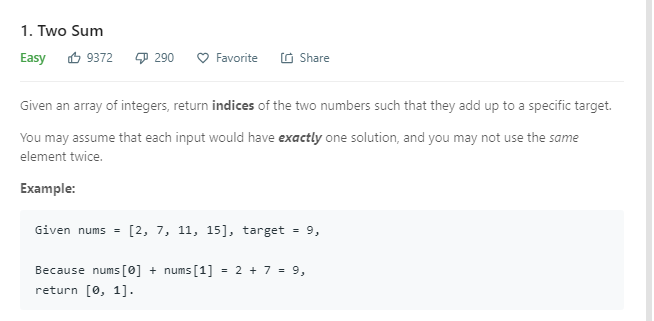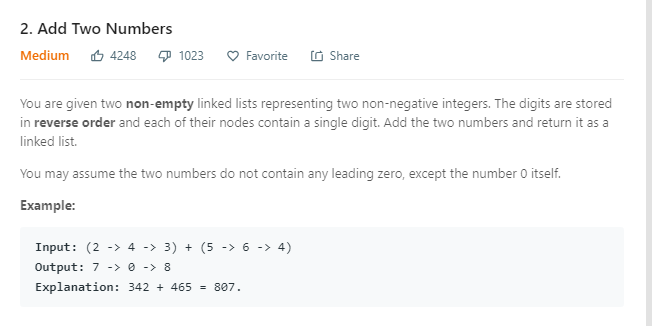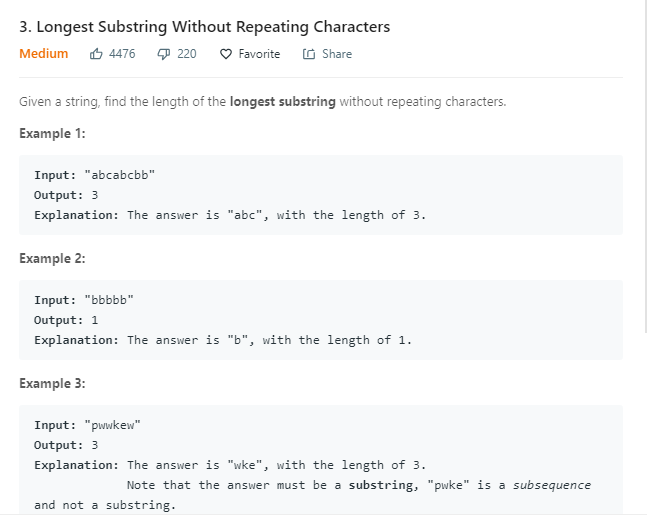leetcode 001 - 003
阿新 • • 發佈:2019-01-04
leetcode 001


程式碼實現
暴力求解行不通,第一次執行成功是用首尾遞迴法。時間複雜度其實也不差,有O(nlogn)。
class Solution: def twoSum(self, nums, target): """ :type nums: List[int] :type target: int :rtype: List[int] """ sNums = sorted(nums) i = 0 j = len(sNums) - 1 while i < j: if sNums[i] + sNums[j] > target: j = j - 1 elif sNums[i] + sNums[j] < target: i = i + 1 else: m = nums.index(sNums[i]) n = nums.index(sNums[j]) if m == n: nums.remove(nums[m]) n = nums.index(sNums[j]) + 1 return [m, n]
上面的程式碼其實太囉嗦了,用索引來迴圈查詢形式上會更簡潔:
class Solution: def twoSum(self, nums, target): """ :type nums: List[int] :type target: int :rtype: List[int] """ sorted_id = sorted(range(len(nums)), key=lambda k: nums[k]) head = 0 tail = len(nums) - 1 sum_result = nums[sorted_id[head]] + nums[sorted_id[tail]] while sum_result != target: if sum_result > target: tail -= 1 elif sum_result < target: head += 1 sum_result = nums[sorted_id[head]] + nums[sorted_id[tail]] return [sorted_id[head], sorted_id[tail]]
這是答案上的最佳實踐,時間複雜度O(n)。
class Solution: def twoSum(self, nums, target): """ :type nums: List[int] :type target: int :rtype: List[int] """ hashmap = {} for index, num in enumerate(nums): another_num = target - num if another_num in hashmap: return [hashmap[another_num], index] hashmap[num] = index return None
leetcode 002


程式碼實現
沒什麼好說的,雖然想了挺久,但是弄明白後就是一次過,這裡貼上最後一次優化結構提交的:
# Definition for singly-linked list.
# class ListNode:
# def __init__(self, x):
# self.val = x
# self.next = None
class Solution:
def nextNode(self, node, val):
"""
:type val: int
:rtpe: ListNode
"""
nextNode = ListNode(val)
node.next = nextNode
return nextNode
def plus(self, node1, node2, carry):
"""
:type node1: ListNode
:type node2: ListNode
:type carry: int
:rtype: int, int
"""
v1 = node1.val if node1 else 0
v2 = node2.val if node2 else 0
val = v1 + v2 + carry
return val % 10 , val // 10
def addTwoNumbers(self, l1, l2):
"""
:type l1: ListNode
:type l2: ListNode
:rtype: ListNode
"""
node = head = ListNode(0)
carry = 0
while l1 or l2 or carry:
val, carry = self.plus(l1, l2, carry)
node = self.nextNode(node, val)
l1 = l1.next if l1 else None
l2 = l2.next if l2 else None
return head.nextleetcode 003


程式碼實現
有點用到佇列的思想,但又不一樣。
class Solution:
def lengthOfLongestSubstring(self, s):
"""
:type s: str
:rtype: int
"""
lst = []
length = 0
for i in s:
if i in lst:
while True:
if lst[0] != i:
lst.pop(0)
else:
lst.pop(0)
break
lst.append(i)
length = len(lst) if len(lst) > length else length
return length上面程式碼有一部分可以優化得非常簡單:
#while True:
# if lst[0] != i:
# lst.pop(0)
# else:
# lst.pop(0)
# break
lst = lst[lst.index(i) + 1:]